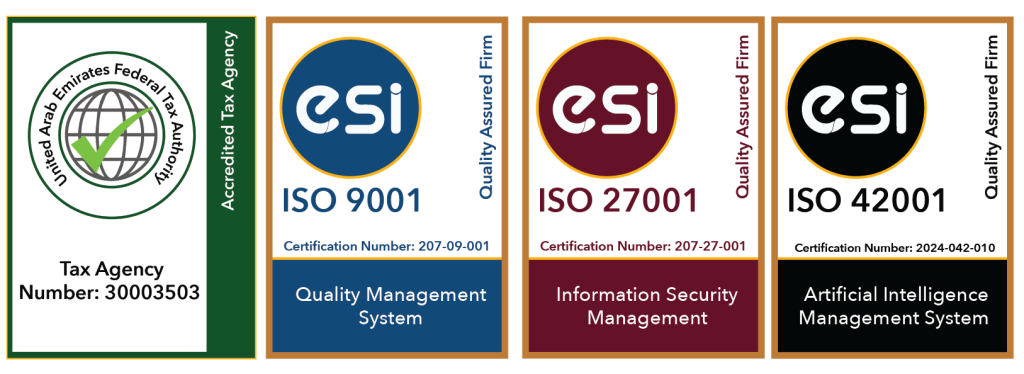From 2027, the Crypto Asset Reporting Framework (CARF) will redefine how the UAE Tax Authority receives information on crypto asset transactions. The UAE Ministry of Finance has signed the Multilateral Competent Authority Agreement (MCAA) in September 2025, to enable automatic exchanges under CARF with UAE implementation scheduled for 2027 and first exchanges in 2028.
While some jurisdictions plan to exchange earlier, UAE exchanges, custodians, and intermediaries, should begin preparing now for UAE tax reporting for digital assets and broader crypto compliance in the UAE.
This article outlines what CARF is, why the UAE is adopting it, the implementation timeline, and the key compliance actions businesses should consider.
What Is the Crypto Asset Reporting Framework (CARF)?
CARF is the OECD’s global standard for the automatic exchange of tax relevant information on crypto asset transactions. It sets out:
- Who reports: Reporting Crypto Asset Service Providers (RCASPs) that can identify users and process transactions.
- What is reported: User identification, tax residency, and transaction data in a standardised format.
- How it is exchanged: Standardised XML schemas and secure transmission between tax authorities.
By extending the principles of the Common Reporting Standard (CRS) to digital assets, CARF aims to address gaps in decentralised models by ensuring reportable events are captured where users can be identified. The OECD has published the XML schemas and user guides, confirming that technical foundations are ready for implementation.
Why Is the UAE Adopting CARF?
The UAE is aligning with international tax transparency while maintaining an innovation friendly environment. Adoption delivers:
- Clear rules for market participants: A recognised framework reduces uncertainty for platforms and investors.
- Cross border compatibility: CARF aligns the UAE with partners that are also adopting the standard, optimising data exchange.
- Complement to domestic regulation: CARF sits alongside Dubai’s Virtual Assets Regulatory Authority (VARA) regime under Law No. 4 of 2022, which governs virtual asset activities across Dubai (outside DIFC).
The Ministry explicitly signed the CARF MCAA in September 2025, announced a go live in 2027, and first exchanges in 2028, following a public consultation window held in late 2025.
CARF Implementation Timeline in the UAE
- September 2025: UAE signs the CARF MCAA, creating the legal framework for exchanges.
- 2025–2026: Industry consultation, rulemaking, and systems build aligned to OECD XML standards.
- 2027: UAE go live for CARF reporting and data capture.
- 2028: First automatic exchanges of UAE CARF data with partner jurisdictions.
Who Will Be Affected by CARF?
CARF applies to RCASPs able to identify users and effect transactions. In practice, this may include:
- Centralised exchanges and custodial wallet providers
- Brokers, marketplaces, and payment processors facilitating crypto transactions
- Other intermediaries acting as counterparties or enabling transfers
These entities will conduct due diligence to determine user identity and tax residence, then report transactions in the prescribed format to the competent authority for cross border exchange.
CARF Compliance Requirements and Preparation Steps
To achieve CARF compliance in the UAE, organisations should focus on five areas:
- Due diligence and self certifications
Collect and validate tax residency self-certifications, integrate checks with existing AML/KYC, and maintain evidence for audits.
- Data model and reporting
Map customer and transaction data to the OECD XML schema. Standardise identifiers, valuations, timestamps, and currency conversions to avoid reconciliation issues.
- Governance and controls
Establish ownership across compliance, legal, data, and engineering. Define data quality checks, exception handling, and retention policies.
- Testing and dry runs
Test reporting processes early against OECD XML standards, reconcile on chain and off-chain data, and address gaps well ahead of the 2027 deadline.
- Monitoring rules and timelines
Track UAE Ministry of Finance publications from the consultation through to final rules, including any local registration or penalty framework.
Global Adoption and Cross Border Impact
CARF is gaining broad support worldwide, with over 60 jurisdictions committed and many already signing the MCAA. This creates a network of reciprocal exchanges that will affect UAE based platforms serving foreign clients and foreign platforms serving UAE residents.
European Union (DAC8)
The EU implemented CARF aligned rules via DAC8. Member States must apply provisions from 1 January 2026, with first exchanges for the 2026 reporting year by 30 September 2027. UAE RCASPs with EU clients should anticipate tighter data alignment and inquiries from EU partners.
United Kingdom and United States
The UK consulted on CARF and amended CRS to enable exchanges from 2027, aligning domestic processes with OECD standards. The US joined a joint statement to work toward CARF exchanges by 2027 and, domestically, is introducing digital asset broker reporting using Form 1099DA (gross proceeds from 2025, basis from 2026, additional DeFi reporting from 2027).
Singapore and Switzerland
Singapore signed the CARF MCAA and expects to commence exchanges in 2028, similar to the UAE’s first exchange date. Switzerland advanced legislation to extend automatic exchange of information to crypto assets from 1 January 2026.
Interaction with UAE Crypto Regulations
CARF addresses tax transparency. Licensing, market conduct, and consumer protection remain under UAE regulators, especially VARA in Dubai under Law No. 4 of 2022. RCASPs should coordinate CARF reporting with VARA requirements and existing AML/KYC frameworks to avoid duplication and ensure consistent data across compliance obligations.
What Should Businesses Do Now?
- Confirm in scope activities: Determine RCASP status and identify reportable transactions across products and jurisdictions.
- Design the data model: Build a CARF data dictionary mapped to OECD XML.
- Embed due diligence: Introduce streamlined, verifiable self-certifications and periodic updates.
- Harden controls: Define owners, QA checks, remediation steps, and retention rules.
- Pilot the process: Produce test files, reconcile data, and fix issues well before 2027.
- Monitor UAE rules: Follow MoF updates from consultation to final regulations.
Conclusion
CARF will become a central part of crypto tax reporting in the UAE. With the UAE go live in 2027 and first exchanges in 2028, early action is essential. Organisations that align systems to the OECD XML, embed robust due diligence, and coordinate with VARA obligations will reduce risk, control costs, and build trust with regulators and clients.
About SimplySolved
As a UAE FTA-approved Tax Agency and ISO 9001, 27001, and 42001 certified provider, SimplySolved supports UAE businesses with CARF readiness and crypto-asset reporting tailored to both local and cross-border requirements. Our consultants define in-scope activities, perform gap assessments, align customer due diligence and tax residency classification with CARF rules, and integrate KYC/AML controls with reporting needs. Services include data mapping to the OECD CARF XML, reporting workflow design, automation of UAE Ministry of Finance submissions for the 2027 go-live, and preparation for international exchanges in 2028.
Our approach combines practical guidance with structured processes to deliver audit-ready records, stronger governance, and reduced operational risk. This enables internal teams to focus on growth while ensuring reliable, cost-effective compliance for CARF and related crypto-asset reporting obligations in the UAE.





